Chipped Beef in Rye Bread Without Celery Salt

This Easy Homemade Rye Bread made with caraway seeds tastes delicious and is a wonderful, wholesome change for sandwiches, toast, or just served with butter along with a meal.
There is nothing like loaves of homemade bread coming out of the oven. Some of our other favorites are Sweet Molasses Brown Bread, Easy Rosemary Focaccia Bread, and Amish White Bread.
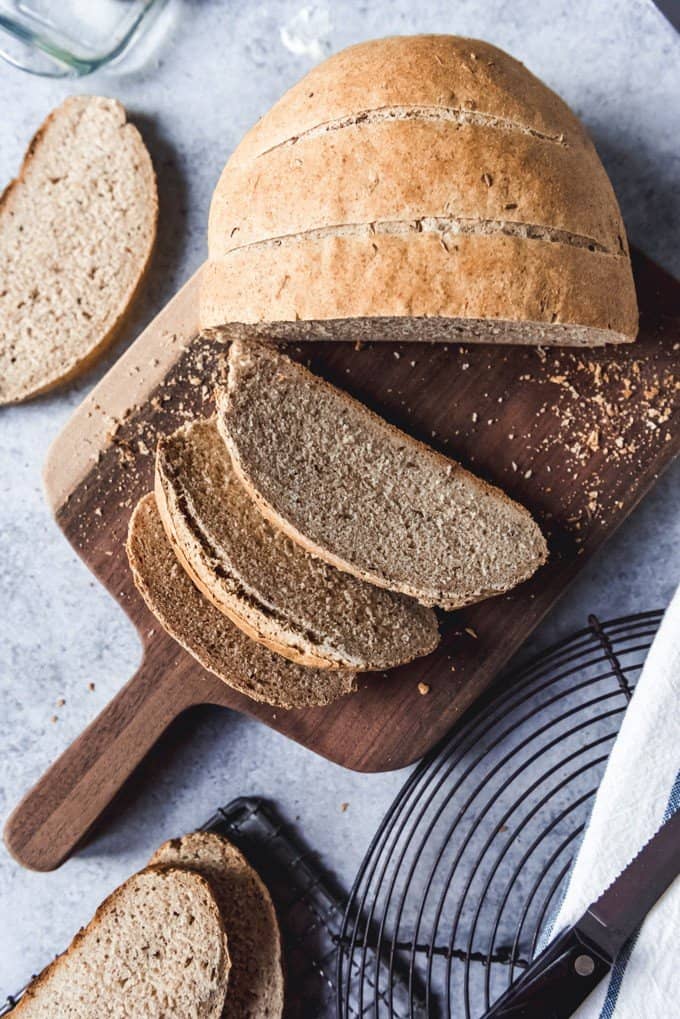
Easy Homemade Rye Bread
I am a big-time bread fan, whether it's a sweet molasses brown bread, a classic loaf of french bread, or a strong caraway rye bread. Bread is one of my favorite foods.
Since I had never made rye bread before, I looked to a lot of resources online to get an idea for how to approach it and what kind of rye bread would work best for my family.
I found this post from the King Arthur Flour site to be super helpful in describing different types of rye bread, if you want to try something a little darker or different than the light sandwich rye that I am sharing today.
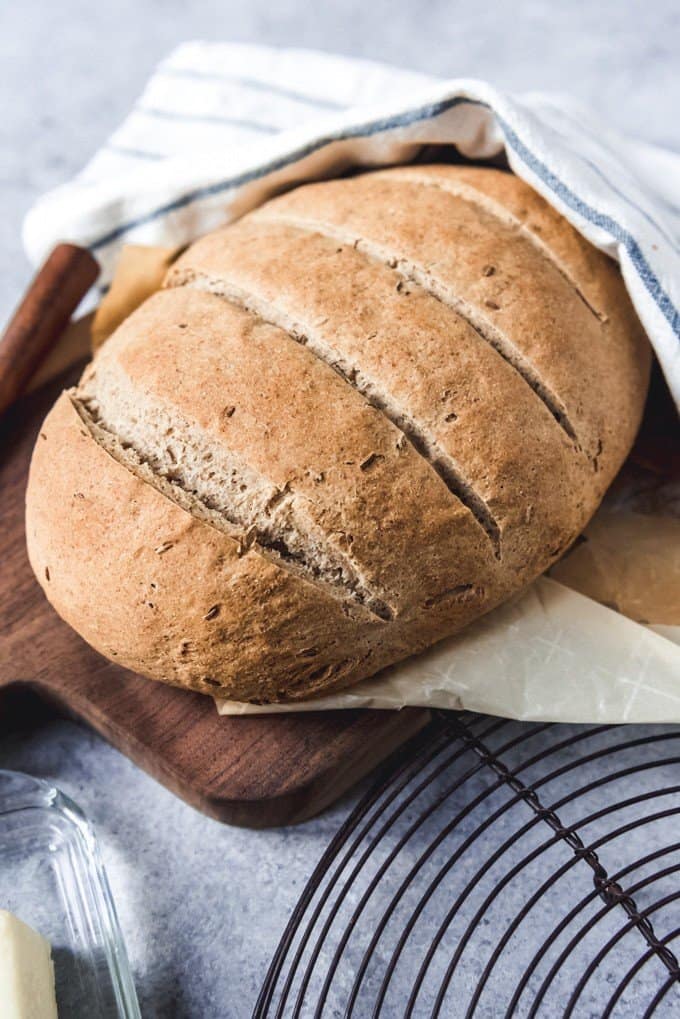
Rye bread can run the gamut from a fruit-and-nut studded loaf to a classic sourdough rye, to the dark, dense pumpernickel (another of my favorite breads that I want to make one of these days!) which is actually a type of rye bread.
And then there is the light, caraway sandwich variety, which is the kind I decided to make.
I wanted to share a simple rye bread recipe that would taste as good with butter and jam at breakfast as with cheese and lunchmeat for a sandwich later in the day.
The reason caraway seeds matter in this bread is that rye bread actually has a fairly mild flavor on its own.
So kneading seeds like caraway, fennel, or anise into the dough or sprinkling seed mixes like Trader Joe's Everything Bagel Topping on top will give distinctive taste to a loaf of rye bread.
Caraway seeds are what are in the rye bread at my favorite German restaurant, so that's what I went with this time around.
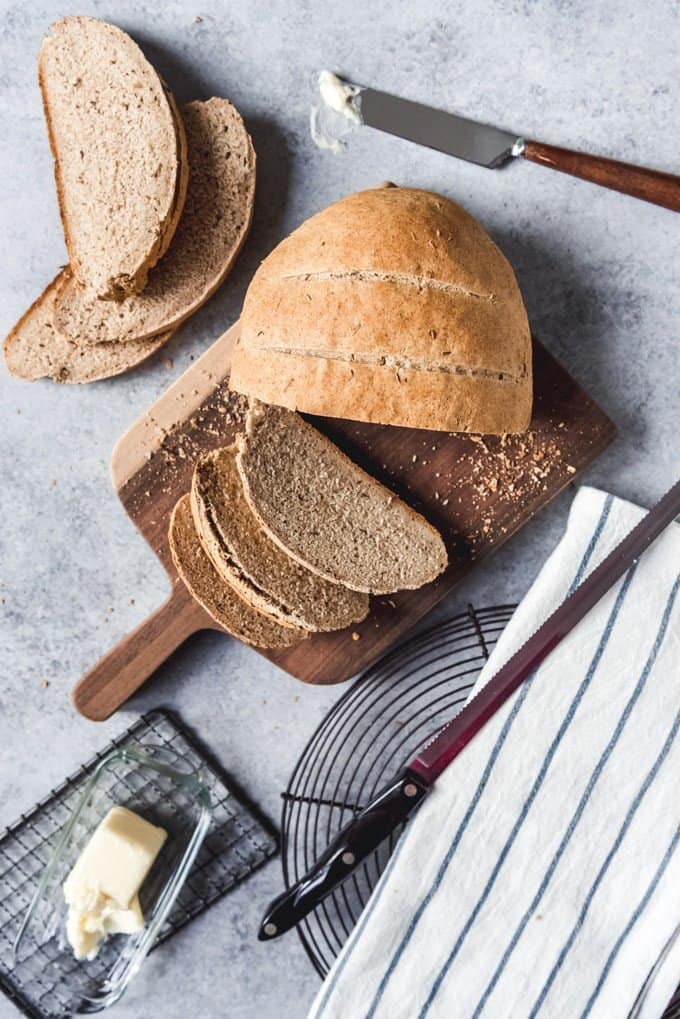
My friend Jenni from The Gingered Whisk and I have been doing a series for the past year where we look at old recipes from a specific time period and recreate them in our home kitchens to feed to our families. Sometimes we try to keep the recipes as close to their historical roots as possible, and other times we tweak them to fit our modern palates.
My first post in the series was last October when I shared a beef steak pie recipe from the Salem Witch Trial period in colonial America.
For this installment, we decided to attempt foods from the Middle Ages, which turned out to be pretty challenging for me. Medieval food recipes are pretty out there, and the more I researched about food in medieval times, the more I realized that I needed to distinguish between the food of the rich and the food of the poor because what you ate was very strongly influenced by where you were in society.
In the Middle Ages, there was a well-defined hierarchy to the social structure with royalty at the top, followed by nobles, then knights, then the clergy, then tradesmen and peasants. You were born into a class of people and generally stayed there your entire life, with very little opportunity for advancement.
I ended up choosing a food that better represents that poor peasant class (even though this homemade rye bread recipe is actually still much better than what peasants would have had access to since I used wheat flour along with rye flour), and Jenni made Sheet Pan Spiced Pork Meatballs in Almond Sauce with Roasted Vegetables, which is based on an actual medieval recipe and represents the food of the higher classes who had access to much more protein and many more spices to vary their diet.
I have seen recipes very similar to the one I am sharing described alternately as Jewish, Polish or German. I didn't do any in-depth research into the differences of each, but from a cursory look at quite a few different recipes, I would say this is closer to the Jewish or Polish versions.
Although it makes sense that this would be classified German as well because it tastes very much like the bread served at our favorite authentic German restaurant in San Francisco.
When were the Middle Ages?
The Middle Ages, also known as the Medieval Period in Europe, lasted from the 5th to the 15th centuries. There are actually three different periods known as the Early, High, and Late Middle Ages, each with their own distinctions, but we didn't decide to focus on any one period when selecting our recipes.
It's a fascinating, confusing time in history though, with changes like the rise of kingdoms and the social structures that we typically think of when looking back at the middle ages. Knights and nobles controlled lands that were rented to peasants who were organized into small villages.
There was climate change known as the medieval warm period that increased the ability to grow crops, followed by plague and famine and war. It must have been a tough time to be alive.
What did Peasants eat in the Middle Ages?
Peasants worked long hours just to ensure that their family had even the simplest food to eat.
Most peasants were farmers who leased their land from the nobles or knights and were taxed by the lord and to the king of the place they lived. Their diet mostly consisted of bread (though not like the bread we immediately think of today), porridge, vegetables and maybe some meat, if they were lucky.
Many members of the lower class would die in times when the weather was too wet or too dry because if their crops failed, the peasants wouldn't have food to eat.
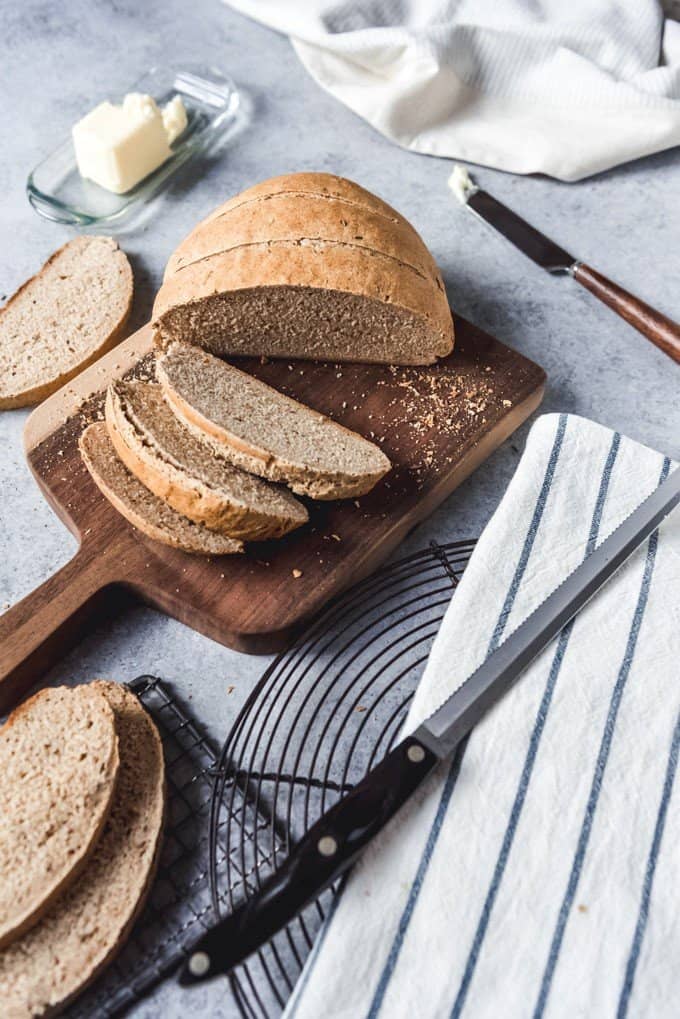
Here are some of the common foods eaten by the lower classes during the Middle Ages:
- rye or barley bread (the most important component of any Medieval diet)
- homegrown vegetables (parsnips, lettuce, beets, chickpeas, celery, carrots, artichokes, cabbage, leeks, peas, cucumber, garlic, onions, shallots, etc.)
- pottage (a type of stew made from peas, beans, and onions from the garden)
- fresh eggs from chickens kept by the peasants
- dairy products like cheese and milk if they were lucky enough to have goats or a cow
- meat like beef, pork, or lamb (but again, only infrequently - only Lords and Nobles were allowed to hunt deer, boar, hares and rabbits and peasants could be punished for poaching by having hands cut off or even being put to death).
- fish (if they lived near freshwater rivers or the sea)
- gathered fruit and berries from local trees and bushes
- honey
- nuts
The bread eaten by the lower classes was often cooked at home in the embers of their hearths. Typically, this bread was not leavened and so was heavy and practically indigestible right when it came out of the oven.
Instead, the loaves (also known as trenchers) would be used as plates for other food and would only be eaten once they became saturated with sauces or gravy. These trenchers were used by both upper and lower classes.
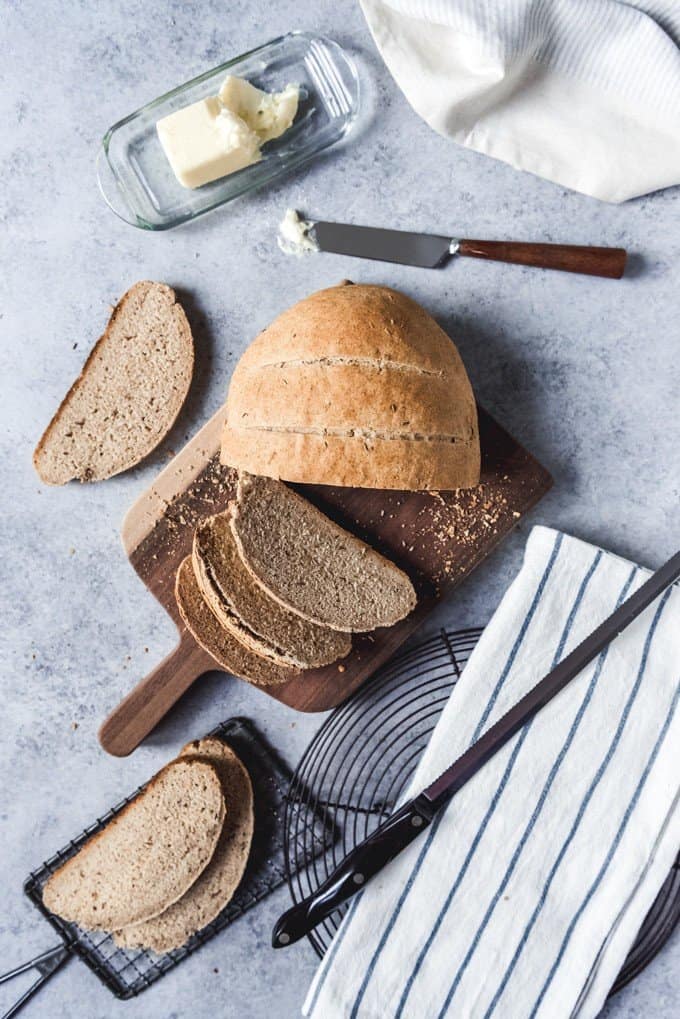
Bread made with barley, oats, or millet was considered coarse among the upper classes who ate a type of wheat bread called "manchet". Sometimes barley bread was even used as a punishment and monks who had committed some serious offence were condemned to live on it for a period of time.
Rye bread was darker and heavier than barley bread, and considered even less palatable. While barley bread was the most popular and common type of bread for most of the Middle Ages, by the late Middle Ages many people in northern Europe were eating rye bread instead because rye was easier to grow in the cold, wet conditions.

If you are interested in reading more, this is a helpful resource.
What did the Rich People Eat in the Middle Ages?
Bread was still a major part of the diet of the upper classes during the Middle Ages, but it tasted a lot better since it was made from wheat, which was more difficult to grow. Here is a list of foods that the Lords and Ladies of the Middle Ages ate:
- Bread made from wheat (known as Manchet)
- A wide variety of meat and game, including venison, beef, pork, lamb, rabbit, goat, swan, geese, and other poultry
- Fish, from freshwater rivers and streams or the sea, depending on the location
- Shellfish like crabs, oysters, and mussels
- Spices from faraway places like India, including pepper, cinnamon, cloves, nutmeg, ginger, saffron, cardamom, coriander, cumin, garlic, turmeric, mace, anise, caraway, and mustard. Even salt was often too expensive for the poor.
- Cheeses
- Fruit, which was commonly served as dessert and preserved in honey
- Few vegetables, and typically not root vegetables, which were considered as lower class
Is Rye Bread Good for You?
I'm not a nutritionist, but I can tell you that rye bread is lower in gluten content than other, all wheat flour breads. This version still has wheat in it, so it isn't gluten-free, but it is lower on the glycemic index so it is less likely to spike your blood sugars than all-white bread.
Rye bread also has higher fibre content than white bread. And since this is homemade bread, it's free from preservatives and additives and all that other stuff.
Plus, I don't know, it justtastes like it is doing good things for you. And that has got to count for something!
How to Make Homemade Rye Bread
I think it's clear by now that my recipe for homemade rye bread differs from authentic Medieval bread, especially the kind that would have been eaten by the lower classes, for a few reasons.
One of those reasons is that I use yeast to leaven the bread and make a soft loaf that is delicious to eat sliced and spread with butter.
I also combined three different types of flour - rye flour, whole wheat flour, and bread flour, to get a softer, more tender bread with more "lift" than 100% rye bread.
But even with these changes, this bread is certainly different from the standard loaves you might get at the store. And it's a great way to introduce your family to new flavors that are a little more unusual than what they might be used to.
Making this homemade rye bread uses the same techniques as making any other loaf of bread. Start by proofing your yeast in some warm water with a little honey.
Then it's just a matter of kneading in a little salt with the different types of flour and the caraway seeds.
Incidentally, if you are wondering what else to use caraway seeds for so they aren't just sitting in your cupboard for making loaves of rye bread, try this rotkohl recipe or sauerkraut and sausages with apples that is one of our family's favorite dinners during cold weather months.

The loaf might take a bit longer to rise than most loaves since rye has less gluten in it, but the shaping and baking are all the same.
You could bake this homemade rye bread in a bread pan for a higher "sandwich" looking bread, of just place it on a baking sheet on a piece of parchment paper for a more rustic, artisan looking loaf like you see in these pictures.
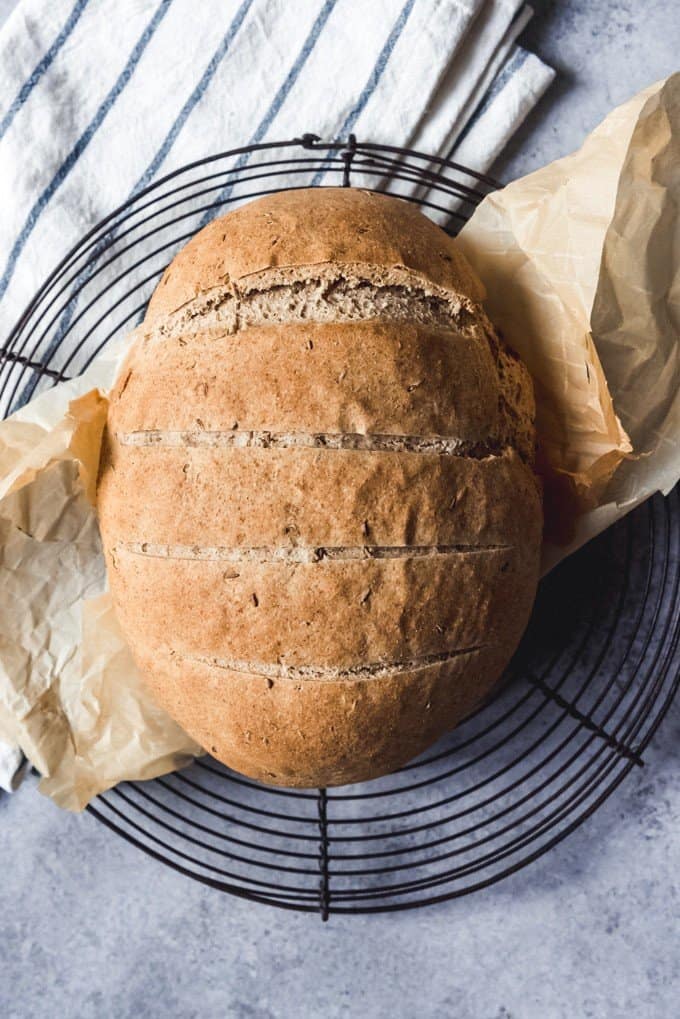
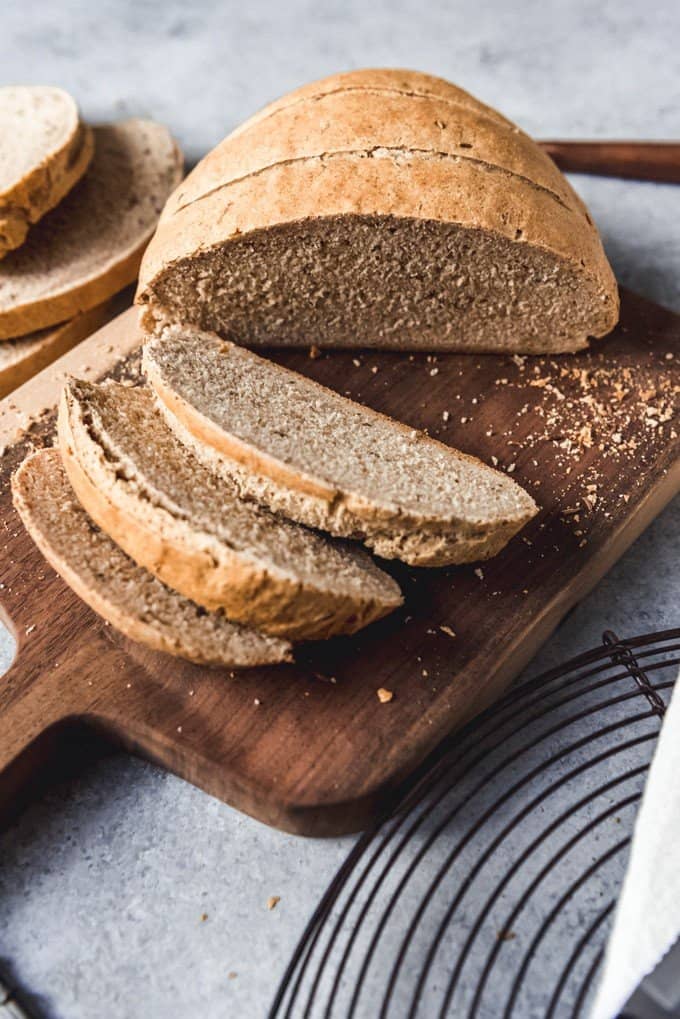
Then slice and enjoy! Do you like to make bread at home? Let me know what kind in the comments below!
More Homemade Bread Recipes You'll Love to Bake
- Sweet Molasses Brown Bread
- Homemade French Bread
- Irish Soda Bread
- Amish White Bread
Did you make this recipe?
Let me know what you thought with a comment and rating below. You can also take a picture and tag me on Instagram @houseofnasheats or share it on the Pinterest pin so I can see.
- ½ cup warm water 110-115 degrees F
- 1 Tablespoon honey
- 1 ½ Tablespoons active dry yeast
- 1 cup whole milk room temperature
- 2 teaspoons salt
- 2 Tablespoons oil
- 1 to 1 ½ cups bread flour
- 1 to 1 ½ cups whole wheat flour
- 1 ½ cups dark rye flour
- 2 Tablespoons whole caraway seeds
-
In the bowl of an electric stand mixer fitted with a hook attachment, combine the warm water and honey, then sprinkle the yeast on top of the water and let it proof for 5 minutes.
-
Add the milk, salt, oil, bread flour, whole wheat flour, rye flour, and caraway seeds to the yeast mixture and knead on medium-low speed until the dough starts to come together. I always start with the lower amount of bread and whole wheat flours listed, then add more as needed.
-
Increase the speed to medium-high and knead for 8-10 minutes until the dough is smooth and no longer sticking to the sides of the bowl.
-
Place the dough in a large, lightly oiled bowl and cover with a towel. Let the dough rise in a warm place until doubled in size, about 1 ½ hours.
-
When the dough has risen, punch it down and transfer to a clean work surface. Let it rest for 5 minutes, then shape it into a loaf and transfer to a baking sheet lined with parchment paper. Cover with a towel and let rise for another hour until doubled in size again.
-
When the dough is close to being doubled in size, preheat the oven to 425 degrees F. Slash the dough with a sharp knife to create gashes on top. Open the oven and throw a few ice cubes on the bottom when you place the bread in to bake. This will create steam that will make for a great crust to the bread. Bake for 30 minutes until crusty and golden brown.
- Rye flour has a lower gluten content than regular flour, so it will typically take a little longer to rise than other loaves.
- I had a previous omission in the recipe where I had typed in 3 cups of bread flour and 1 ½ cups of the rye flour. I have since changed it to 1 ½ cups of bread flour, 1 ½ cups of whole wheat flour, and 1 ½ cups of rye flour. I find that both ways work, but the version with the whole wheat is heartier.
Adapted from Sarcastic Cooking.
Calories: 138 kcal | Carbohydrates: 24 g | Protein: 4 g | Fat: 3 g | Saturated Fat: 1 g | Polyunsaturated Fat: 1 g | Monounsaturated Fat: 2 g | Trans Fat: 1 g | Cholesterol: 2 mg | Sodium: 341 mg | Potassium: 109 mg | Fiber: 3 g | Sugar: 2 g | Vitamin A: 32 IU | Vitamin C: 1 mg | Calcium: 32 mg | Iron: 1 mg
Source: https://houseofnasheats.com/homemade-rye-bread/
0 Response to "Chipped Beef in Rye Bread Without Celery Salt"
Post a Comment